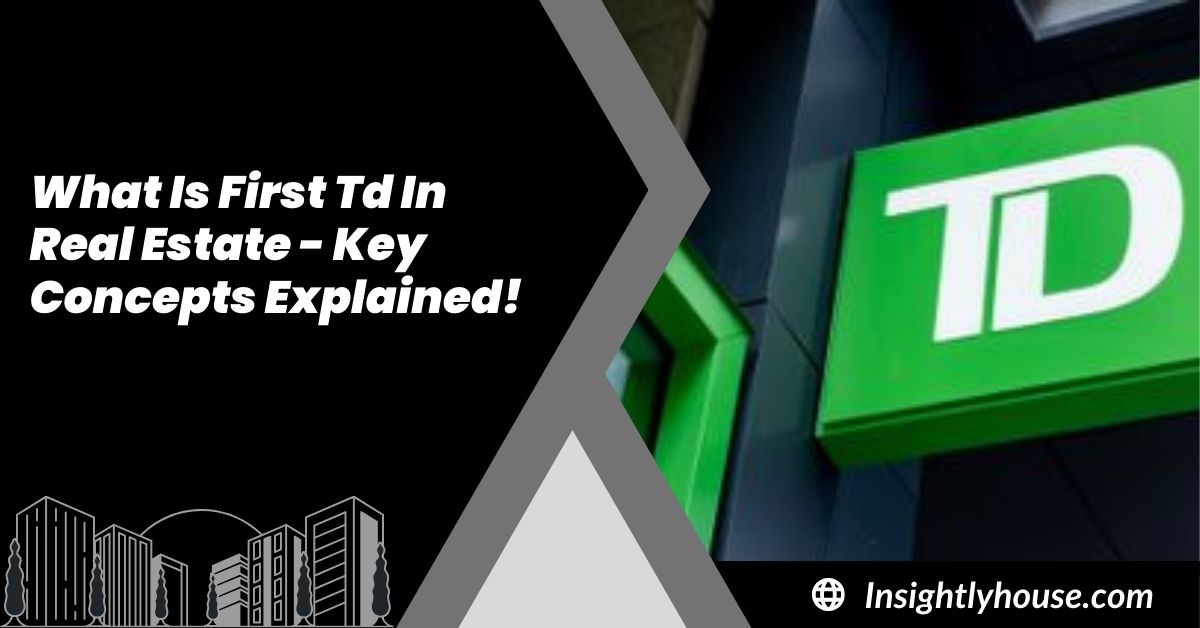Understanding financial instruments is crucial for both buyers and investors. One such instrument is the first trust deed (First TD).
A first TD is a legal document that secures a loan against a property, giving lenders priority over other claims.
This article delves into what is First TD in real estate, how it operates, and its significance in real estate transactions.
What Is First TD In Real Estate?
A first TD is a trust deed secured by a loan that holds priority over other liens on the property. What Is First TD In Real Estate Example? Suppose you are purchasing a home for $300,000. You secure a loan of $240,000 with a first TD.

In the event of a foreclosure or sale of the property the lender holding the first TD will receive the proceeds from the sale to pay off the $240,000 loan before any other creditors are paid.
If you default on the loan, the lender can initiate foreclosure proceedings, sell the property, and use the proceeds to satisfy the debt.
Difference Between Trust Deeds and Mortgages!
While both trust deeds and mortgages serve as security for loans, there are key differences between the two:
- Parties Involved: A mortgage involves only two parties—the borrower and the lender. In contrast, a trust deed involves three parties: the borrower, the lender, and a trustee.
- Legal Title: In a mortgage agreement, the borrower retains legal title to the property, while in a trust deed, the trustee holds the legal title until the loan is fully repaid.
- Foreclosure Process: The foreclosure process for trust deeds is generally quicker and less complex than that of mortgages. In most states, trust deeds allow for non-judicial foreclosure. Which means the lender can foreclose without going through the court system.
First TD vs. Mortgage:
While both first trust deeds and mortgages serve as mechanisms to secure loans, there are key differences between them. These differences impact both borrowers and lenders, and understanding them is essential for navigating real estate financing.
A first trust deed involves three parties: the borrower (trustor), the lender (beneficiary), and a neutral third party (trustee). A mortgage involves only two parties: the borrower and the lender.
First TD Investing:
Investing in first TDs allows individuals to participate in real estate financing as private lenders. These investments offer relatively low risk because they are secured by the property itself. When you invest in a first TD you can become the lender.
Investors are typically paid regular interest income and in the event of borrower. They have the right to foreclose and take ownership of the property. This type of investment is appealing because it offers predictable returns and the security of real estate collateral.
Read More: Bermuda Real Estate – Luxury Homes & Investment Deals!
The Legal Framework of First TDs in the USA:
Understanding the legal framework for first trust deeds (First TDs) is important for lenders and borrowers in real estate. This framework includes federal, state, and local laws that guide how first TDs work, the rights of everyone involved, and the process if a borrower defaults.

Federal Regulations:
Several federal laws influence first TDs:
- Truth in Lending Act (TILA): Requires lenders to clearly explain loan terms and costs.
- Real Estate Settlement Procedures Act (RESPA): Protects consumers by ensuring transparency in the loan process.
- Equal Credit Opportunity Act (ECOA): Prevents discrimination in lending based on race, gender, age, or public assistance status.
State Laws:
Each state has its own rules for first TDs, including:
- Foreclosure Procedures: States have different processes for foreclosure. Which is how lenders reclaim property if a borrower fails to pay. Some states use court processes, while others allow lenders to foreclose without going to court.
- Right of Redemption: Some states allow borrowers to reclaim their property after foreclosure by paying what they owe.
- Anti-Deficiency Laws: In some states, lenders cannot pursue borrowers for additional money if the sale of the property doesn’t cover the loan amount.
Local Regulations:
Local governments may have specific rules regarding first TDs including zoning laws and property taxes. It’s important for borrowers and lenders to know these rules, as they can affect the transaction.
Legal Documentation:
Important legal documents for first TDs include:
- Deed of Trust: This document secures the loan and outlines the relationship between the borrower, lender, and trustee.
- Promissory Note: A written promise from the borrower to repay the loan, including details like the loan amount and interest rate.
- Loan Agreement: This document outlines the terms and conditions of the loan.
Importance of First TD
The first TD plays a vital role in the real estate market by providing security for lenders. When a borrower defaults on their loan, the lender can initiate foreclosure proceedings to recover their investment. This process involves selling the property to pay off the loan.
Significance for Lenders:
For lenders, the first TD offers a reliable means of securing their investment. The priority status of the first TD means that lenders are more likely to recover their funds in the event of a default. As a result, loans secured by first TDs often come with lower interest rates than unsecured loans or second trust deeds.
Significance for Borrowers:
For borrowers, understanding the implications of a first TD is essential. The agreement carries legal obligations that must be met to avoid foreclosure. Furthermore, the presence of a first TD affects the borrower’s ability to secure additional financing, as subsequent lenders will consider the priority of existing debts.
Read More: Money6x.Com Employment – #1 Platform for Flexible Earning!
Benefits of Investing in First TD!
Investing in first TDs offers numerous benefits for investors looking to diversify their portfolios:

Predictable Returns:
First TDs typically provide stable interest rates, allowing investors to predict their returns accurately. This predictability can be particularly appealing in volatile markets, where other investments may be subject to rapid fluctuations.
Collateralized Investment:
Since the loan is secured by real property, investors face less risk compared to unsecured investments. In the event of default, the investor can take possession of the property through foreclosure, which serves as a safety net for their investment.
Diversification:
Adding first TDs to an investment portfolio can enhance diversification, reducing overall investment risk. Real estate typically behaves differently than stocks and bonds, so including first TDs can help stabilize returns across a broader range of market conditions.
Passive Income:
Investors receive regular interest payments without the need to manage physical properties. This passive income stream can provide a reliable cash flow, making first TDs an attractive option for those looking to generate income without active management.
Risks Associated with First TD!
Despite the advantages investing in first TDs also carries risks that investors should consider:
Market Fluctuations:
Real estate values can rise or fall affecting the value of the collateral securing the loan. A downturn in the real estate market may reduce the property’s value below the loan amount, making it challenging for investors to recover their investment in case of foreclosure.
Foreclosure Risks:
If the borrower defaults the foreclosure process can be lengthy and costly, potentially impacting the investor’s returns. Although first TDs provide a level of security, the process of selling a foreclosed property can lead to additional expenses and delays.
Legal Considerations:
Investors must understand the legal implications of first TDs including the foreclosure process and their rights as lenders. Navigating the complexities of real estate law can be challenging, and failing to adhere to legal requirements may result in financial losses.
The Process of Securing a First TD!
Securing a first TD begins with the application process. Borrowers must provide financial documentation including income statements, credit reports, and information about the property.
Application Process:
Lenders will assess the borrower’s creditworthiness and the property’s value to determine eligibility.
- Documentation: The borrower submits necessary documents, including proof of income, employment verification, and existing debt obligations. These documents help lenders evaluate the borrower’s ability to repay the loan.
- Credit Check: Lenders conduct a credit check to assess the borrower’s credit score and history. A higher credit score increases the likelihood of loan approval and can lead to better interest rates.
- Property Appraisal: Lenders typically require an appraisal to determine the property’s market value. This step is crucial for ensuring that the property is worth the amount being borrowed.
- Underwriting: After reviewing the application and conducting an appraisal, the lender’s underwriting team evaluates the risk associated with granting the loan. If approved, the loan terms will be outlined in the first TD agreement.
Closing Process:
The closing process involves signing the first TD and other related documents. The borrower will also pay closing costs.Which can include appraisal fees, title insurance, and other expenses. After closing the first TD is recorded with the county.
- Final Review: Before closing, borrowers should review the loan documents carefully to ensure they understand the terms and conditions. This includes the interest rate, repayment schedule, and any potential fees.
- Signing Documents: During the closing meeting, borrowers sign the first TD and other necessary documents, such as the promissory note and closing disclosures.
- Payment of Closing Costs: Borrowers typically pay closing costs at this time. These costs can vary based on the lender and the property, so it’s essential to budget accordingly.
- Recording the Deed: After closing, the lender will record the first TD with the appropriate county office. This legal step establishes the lender’s interest in the property and ensures that it is recognized as the primary lien.
Read More: Is Real Estate Investment Trusts a Good Career Path?
First TD vs. Second TD – Key Differences!
When navigating real estate financing, understanding the differences between first trust deeds (First TDs) and second trust deeds (Second TDs) is essential. Both are types of loans secured by property, but they differ in several important ways. Here’s a simple breakdown:
Loan Amount and Interest Rates:
- First TD: These loans are typically larger with lower interest rates. Since the first TD is considered less risky (as it is in the first position), the lender offers better terms.
- Second TD: Second TDs are usually smaller loans with higher interest rates. They carry more risk because they are repaid after the first TD in case of a default.
Purpose and Use of Funds:
- First TD: A first TD is often used for the primary purpose of purchasing or refinancing the property.
- Second TD: A second TD is often used for secondary expenses, such as home improvements, debt consolidation, or additional financing needs that arise after the primary loan is in place.
Foreclosure Risk:
- First TD: If the borrower defaults, the lender holding the first TD has the first claim to the property during foreclosure. This makes it a safer and lower-risk investment for lenders.
- Second TD: The lender holding the second TD faces higher risk, as they are paid only after the first TD lender has been fully repaid. If the foreclosure sale doesn’t cover both loans the second TD lender may lose money.
Example:
Let’s consider an example:
- First TD: You take out a loan of $200,000 to buy a home, which is secured by a first trust deed.
- Second TD: Later, you borrow an additional $50,000 using a second trust deed to fund home renovations.
First TD vs. Other Financing Options:
When comparing first TDs to other financing options, such as second mortgages or personal loans, several distinctions arise:
Priority:
The first TD has priority over all other loans secured by the property, making it less risky for lenders. This priority means that in the event of a foreclosure the lender holding the first TD will be paid first before any other claims are satisfied.
Interest Rates:
First TDs generally come with lower interest rates compared to second mortgages due to their lower risk profile. Lenders are more willing to offer favorable terms because the likelihood of recovery in the event of default is higher.
Foreclosure Rights:
Lenders with a first TD have more straightforward rights in foreclosure situations, allowing for quicker recovery of their investment. The process of enforcing a first TD is typically less complicated.
Flexibility:
While first TDs provide security for lenders, they also offer flexibility for borrowers. For instance, borrowers can refinance their first TD to secure better terms or access equity in their property. This flexibility is often not available with other types of loans.
FAQs:
What Is First TD In Real Estate California?
In California a first TD follows the same fundamental principles as in other states but is governed by specific state laws. California real estate transactions commonly use first trust deeds to secure loans.
What is the First TD Loan?
A first TD loan refers to the loan secured by the first TD on a property. In this arrangement, the borrower receives funds from the lender in exchange for securing the property with a first TD. This type of loan is commonly used for purchasing homes or refinancing existing property loans.
What does TD stand for in real estate?
TD stands for “Trust Deed” in real estate. It’s a legal document that is used to secure a loan on a property. In this process a third party called a trustee (ownership) of the property until the borrower pays off the loan. If the borrower doesn’t pay the lender (the person or company that gave the loan) can take the property.
What is a 2nd TD?
A 2nd TD means a second trust deed. This is a loan that is taken out after the first one. It’s like a second mortgage on a property. If the borrower doesn’t pay the lender who holds the second TD can only get paid after the first TD lender is paid.
What is a first trust in real estate?
A first trust deed (or First TD) is the main loan that is secured by a property. This is the first lien or claim against the property. This type of loan is usually used to buy or refinance a home and has lower interest rates because it’s less risky for the lender.
Conclusion:
What is first TD in real estate is essential for anyone involved in property transactions or investments. The first TD serves as a critical financial instrument that provides security for lenders and offers unique opportunities for investors.
The first TD is a foundational concept in real estate financing that every buyer and investor should understand. Its role as the primary lien on a property makes it a vital component of the real estate landscape.
Read More:
- Why Prime Real Estate Is the Best Investment in 2025!
- How To Become Real Estate Agent? Step-by-Step Guide!
- Redian Real Estate – Best Property Deals in Armagh!
